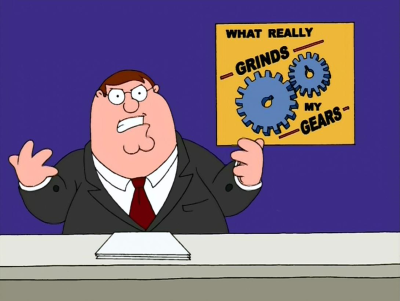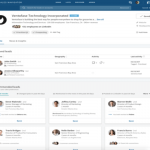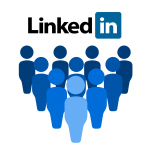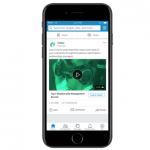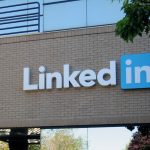What a Wall side road Journal Article bought mistaken About LinkedIn
February 5, 2016

How can a small company take advantage of LinkedIn?
neatly, should you read and adopted a recent Wall street Journal article with the aid of Dr. Alexandrea Samuel, you’d get just a few bits of fine knowledge. however you’d primarily analyze a couple of ways in which I imagine in fact restrict certain small companies’ means to really grow their corporations by the use of LinkedIn and, via extension, Social selling.
organisations which might be trade-to-trade (B2B) centered can—and do!—truly grow their efforts in lead generation, mindshare, referrals via networking and even to close industry through the use of LinkedIn and Social promoting. We’ve considered it happen time and time once more with our personal purchasers.
What’s extra, we see it with shoppers of all sizes; from the individual salesperson who’s an independent contractor to complete gross sales divisions in Fortune 2000 firms, and all situations in between.
 That’s why a bit like this actually will get to me. LinkedIn is a useful gizmo to make use of to develop one’s business, irrespective of how large or small it may well be. It does want to be part of a bigger plan that drives company increase, but it can be a big a part of that plan (relying on quite a few factors).
That’s why a bit like this actually will get to me. LinkedIn is a useful gizmo to make use of to develop one’s business, irrespective of how large or small it may well be. It does want to be part of a bigger plan that drives company increase, but it can be a big a part of that plan (relying on quite a few factors).
And, sure, it might probably work very neatly for small companies.
With that in mind, let’s take a look at some of Dr. Samuel’s advice.
What’s Very, Very wrong
I won’t go into all of her factors on this piece, however I do need to highlight three of the most important problems I see along with her advice.
Don’t focus on lead technology. considering the fact that lead technology is a big part of our training and coaching, i’ve an especially large problem with this one. in brief, Dr. Samuel is having a look at lead technology in the unsuitable means. She asserts that lead technology on LinkedIn is an inbound affair that comes from a industry’s company web page, and that corporations—small ones, especially—should not rely on it for inbound leads.
Dr. Samuels is 100% appropriate about this. however she misses the much higher image of the right way to use LinkedIn for lead generation. It’s most undoubtedly not about inbound leads into an organization page. Lead generation comes from trade owners, salespeople and so forth the usage of LinkedIn in very deliberate and proactive methods.
I’ve written so many articles on the best way to do just this, so I gained’t go into important points right here. talk over with my LinkedIn Pulse page to learn these items.
promote the trade, not your self. I’d flip this one slightly on its head and say “promote the industry, and yourself.” I accept as true with Dr. Samuel’s statement that brand matters greater than a person’s title or place inside an organization. My reply to that, although, is I wish to work with a person who I see is an skilled at an organization with a robust model. I don’t need to take care of somebody who’s just a cog in an admittedly neatly-branded computer, which is what number of LinkedIn Profiles learn lately. when you’re any person who really knows what you might be doing in your field, you will have to be profiting from both your personal brand and your company brand. that occurs via what I name the “above the fold” technique.
a super example of that is what I did with a latest LinkedIn Profile Makeover shopper. lengthy story brief, we used the “above the fold” solution to model each his company and himself as specialists in his box by effectively the usage of all three of the principle attention grabbers of his Profile: the banner historical past, the Profile photograph, and the Headline. We created a simple, yet efficient banner that promoted his firm because the “expert” in his container; on this case, file management and safety. We then used a photo of him that provides that each one-essential first impact that he’s a real skilled. His Headline is written in a WIIFM (“what’s in it for me,” with me referring to the individual studying the Profile) approach that promotes him as the an expert authority in his career. All three of those elements work together to model each him and his firm effectively.
maintain critical job personal. Dr. Samuel asserts that her readers could wish to use a private-looking window when viewing LinkedIn Profiles, because individuals can see who has viewed them and “it’s simple to turn out overexposed when investigating a prospect or competitor.” while that may be authentic to a undeniable degree, it overlooks the main good thing about now not going “stealth.”
This point in reality comes from a primary-stage connection of mine who commented earlier this week on my share of this article. Aaron Schmookler mentioned:
i admire what I do. I understand it’s treasured. i know mainly who it is usually treasured to. If I’m checking you out on LinkedIn, it’s as a result of i feel there may be mutual benefit in a relationship between us. If I’m proper, chances are you’ll see the potential of a mutually really useful relationship as neatly. for those who don’t see that I’ve checked you out, you’re much less likely to recognize the rest about me, much less more likely to see the possible, and we’re both more more likely to fail to see that merit.
at the similar time, Dr. Samuel tells her readers they will have to take a look at who has seen their Profiles, because “it is going to provide helpful insights into their very own trade.” Don’t get me wrong; that’s nice recommendation. actually, i recommend going one step further. I just in finding it attention-grabbing that anyone who suggests hiding their own job also profit from a (valuable) LinkedIn instrument. Aaron is right in his quote and proves that going stealth isn’t find out how to use LinkedIn.
but Wait…
To be truthful, the one tip of hers i love (and already use myself) is to faucet your community while you’re touring. “once salespeople guide the meetings and situations that constitute the primary objective of a trip, they must use LinkedIn to fill the calendar with extra meetings.” She even details how one can use LinkedIn search to filter through geography, connections—search for first- and 2nd-stage connections—job titles and so on. Dr. Samuel then factors out that such trips can be utilized to ask for connections and referrals to others available in the market during which you’re touring.
i admire this very solid tip. I’m in Louisville a couple of instances a month, and i use this system to fill my own calendar. trust me, it really works.
right here’s the object
As I’ve asserted, LinkedIn works perfect in B2B. i’ve seen it work as well with what I name “giant-determination, giant-ticket” corporations which might be industry-to-client (B2C) targeted; including actual property and financial services and products (banking, financial planners, insurance coverage and so forth). For companies that fall out of doors of these areas, she’s right about now not the usage of LinkedIn for a direct Social-selling plan. As Dr. Samuel asserts, these varieties of companies should use tools like fb, Pinterest or Instagram.
but even for these businesspeople, LinkedIn should be part of a networking effort to expand connections, network and probably achieve referrals. One big motive at the back of this is something Dr. Samuel factors out in her piece: requesting assist. Most any person can tap into the person and collective wisdom that one’s LinkedIn community offers for assistance in responding to an RFP (request for concept), shopping for a provide-chain administration tool and so on. She has some just right tips about how one can do it, too.
total, I’d say while there are some just right guidelines for companies total, the principle thrust of her article limits the effective use of LinkedIn, particularly for B2B corporations. That’s why I’d avoid about 70% of what she recommends.
this text was once also revealed on LinkedIn.
Digital & Social Articles on business 2 community
(62)

